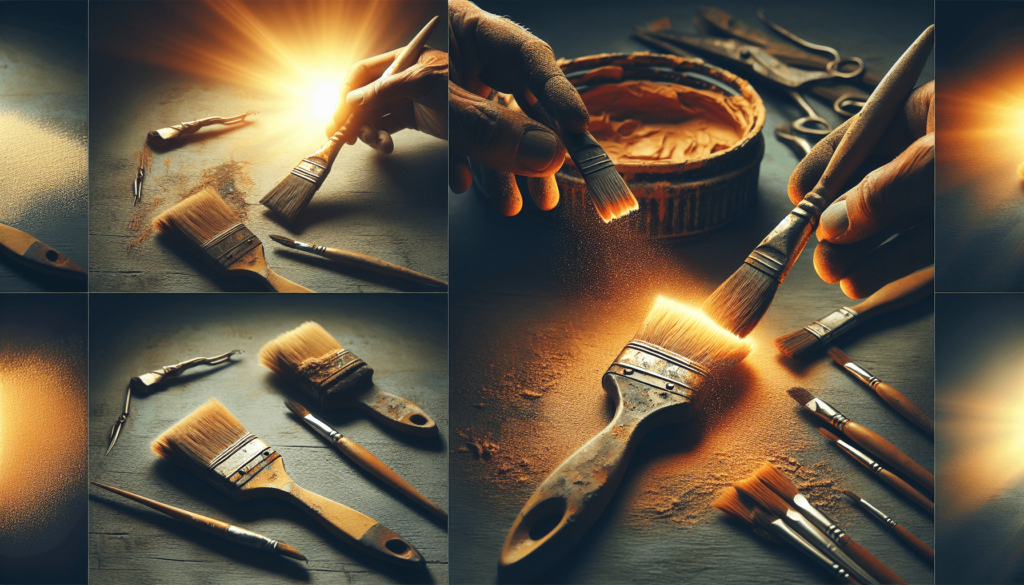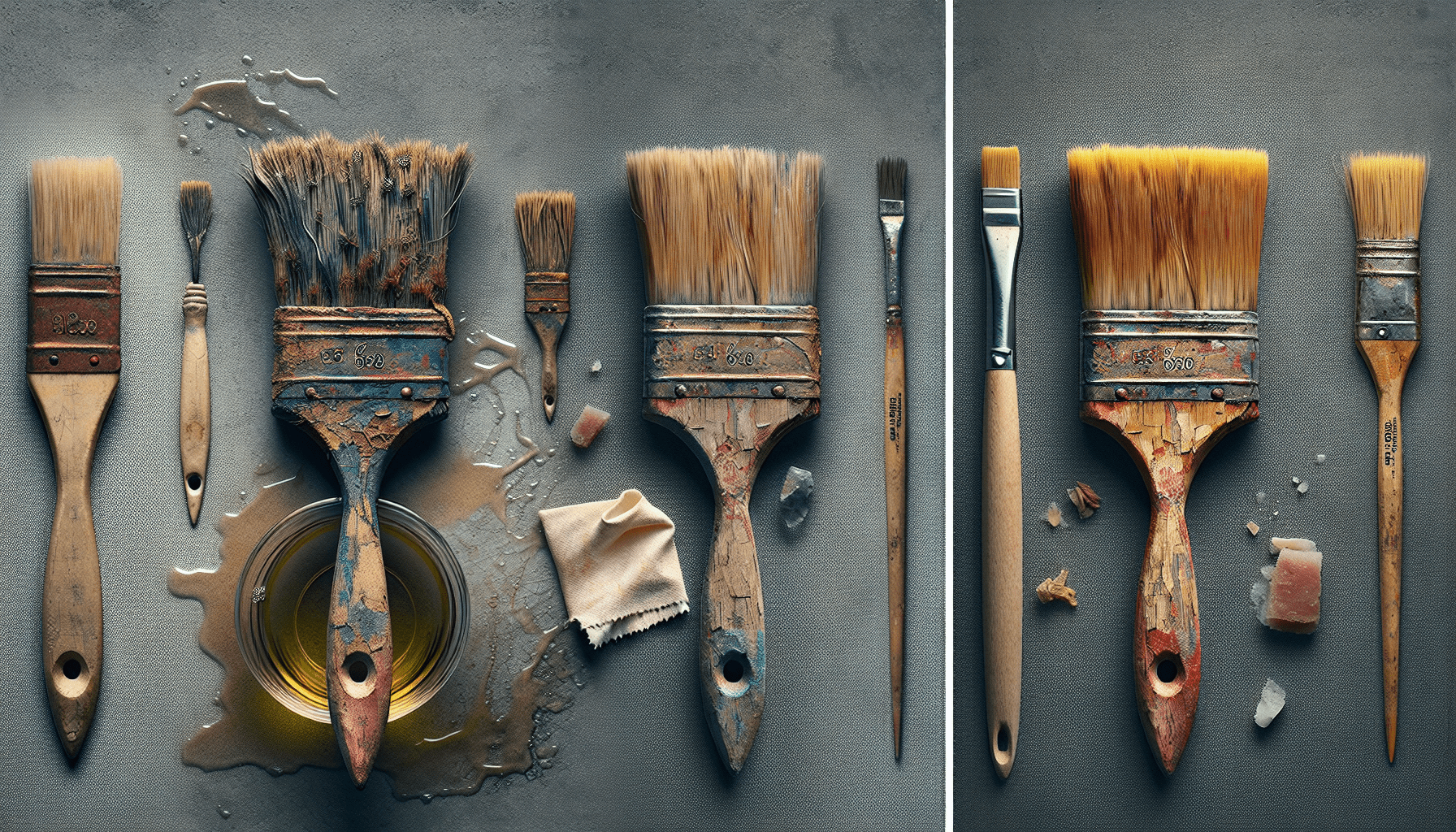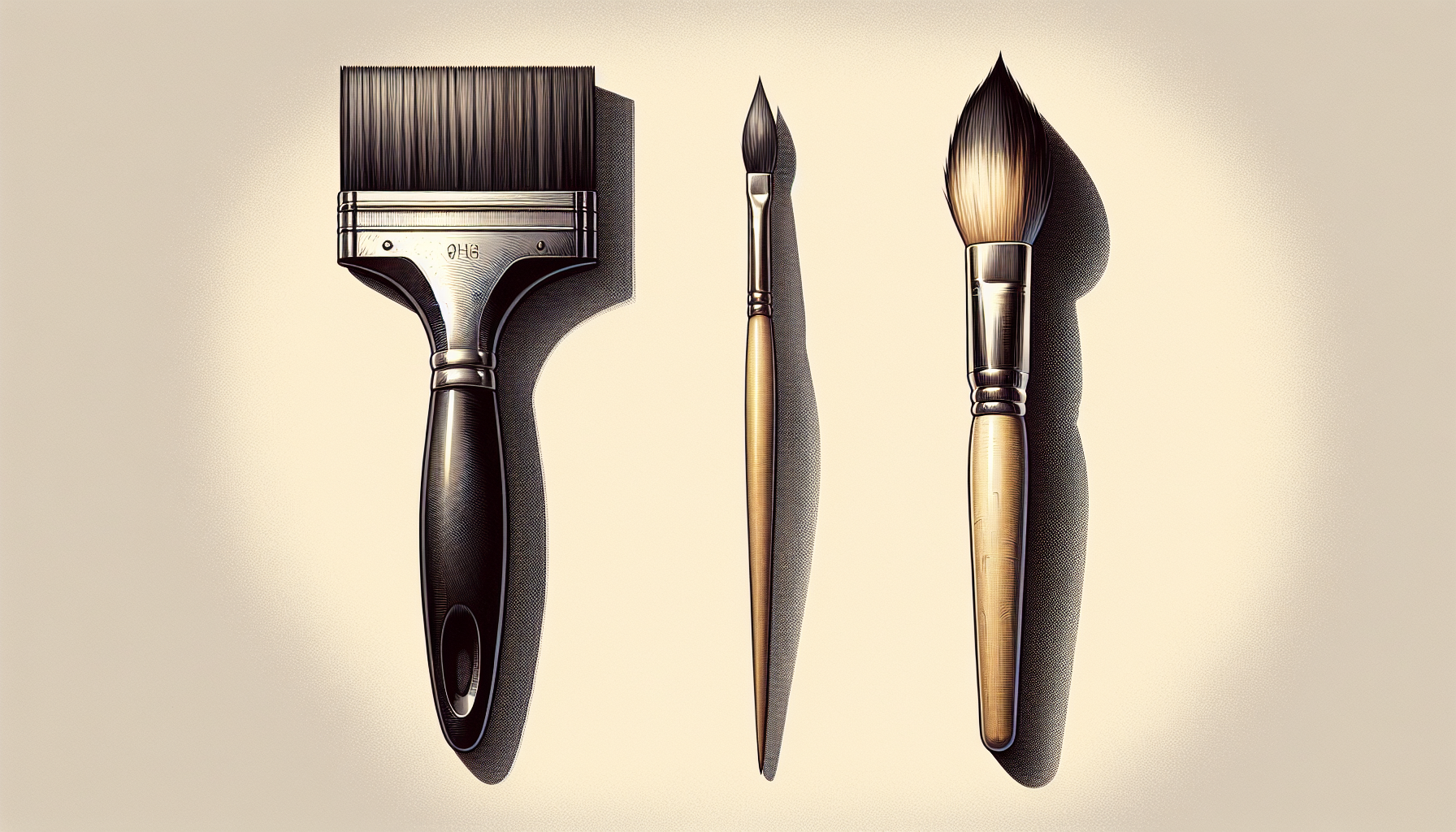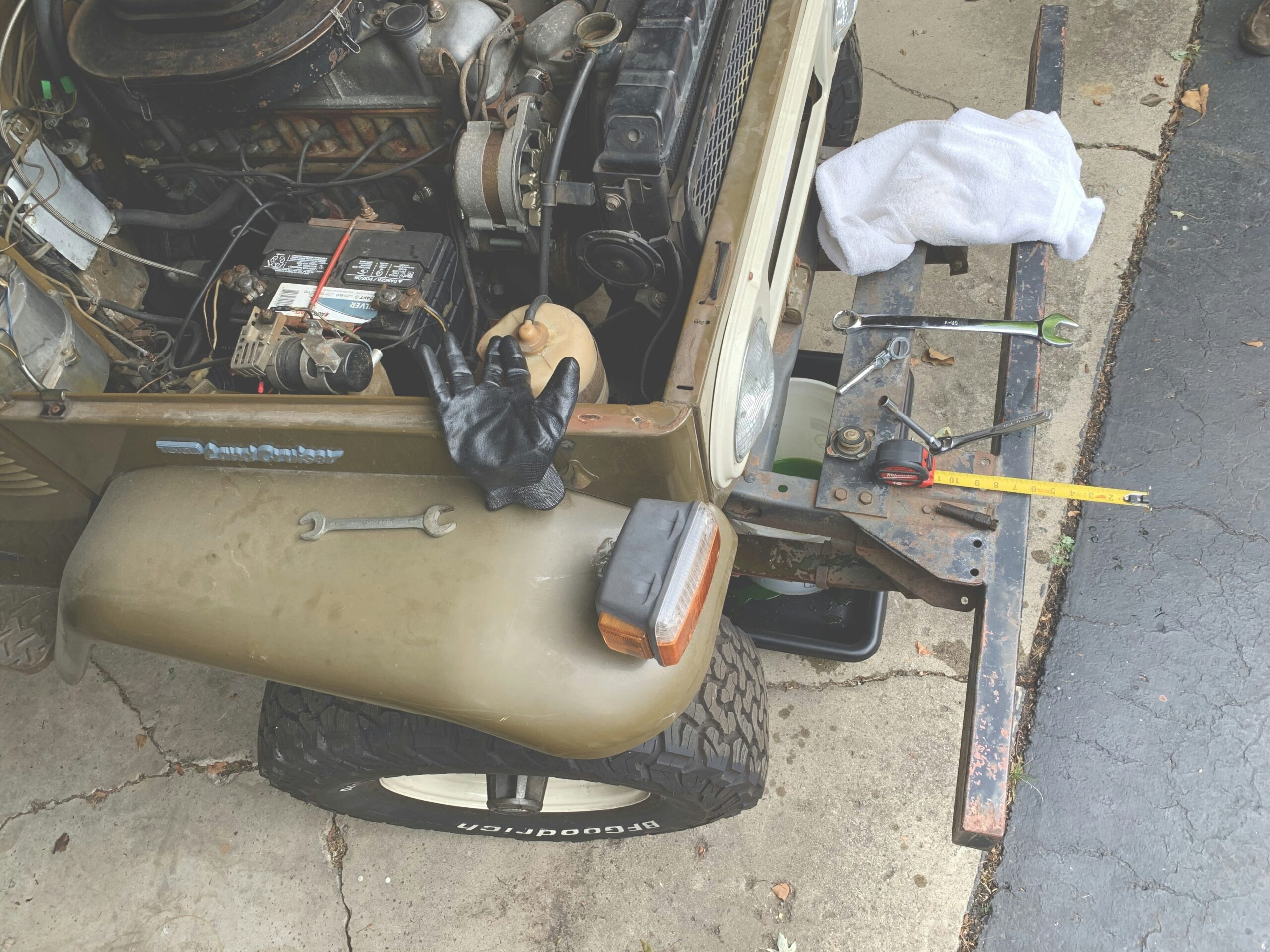In the realm of painting, the tools you use can greatly impact the outcome of your masterpiece. As a skilled artist, it is crucial to maintain the quality and effectiveness of your paint brushes. In this article, you will discover a simple yet effective method to renew your paint brushes, ensuring their longevity and performance throughout your artistic journey. Say goodbye to frayed or hardened bristles, and embrace the art of brush care and restoration.

Clean the Brushes
Remove Excess Paint
To start the process of renewing your paint brushes, you should first remove any excess paint from the bristles. This can be done by scraping the brush against the edge of the paint can or a scrap piece of cardboard. By removing as much paint as possible, you’ll make the cleaning process much more effective.
Soak in Water
After removing the excess paint, it’s important to soak the brushes in water. Fill a container with warm water and place the brushes in it, making sure that the bristles are completely submerged. Let the brushes soak for about 15 minutes to help loosen any remaining paint.
Use Mild Soap
Once the brushes have soaked adequately, you can proceed to using a mild soap to clean them. Avoid using harsh chemical cleaners, as they can damage the bristles. Gently work the soap into the bristles, using your fingers or a brush cleaning tool. This will help to break up any paint remnants and remove any dirt or debris that may be trapped in the bristles.
Rinse Thoroughly
After cleaning the brushes with mild soap, it’s important to rinse them thoroughly to remove any residue. Use clean running water to rinse the bristles, making sure to remove all traces of soap. Repeat this process until the water runs clear, indicating that the brushes are clean. Squeeze out any excess water gently and reshape the bristles if needed. The brushes are now clean and ready for the next step in the renewal process.
Remove Hardened Paint
Scrape with a Comb
Sometimes, paint can harden on the bristles of a brush, making it challenging to remove. In such cases, a comb can be a handy tool. Use the comb to scrape the hardened paint off the bristles, taking care not to damage the bristles themselves. By gently working the comb through the bristles, you’ll be able to break apart the hardened paint and loosen its grip on the bristles.
Soak in Vinegar
If scraping with a comb doesn’t fully remove the hardened paint, it’s time to turn to vinegar as a solution. Fill a container with white vinegar and place the brushes in it, ensuring that the bristles are fully submerged. Let the brushes soak for several hours or overnight, allowing the vinegar to soften the hardened paint. After soaking, rinse the brushes with water and proceed to the next step.
Use Paint Brush Restorer
In cases where vinegar doesn’t completely remove the hardened paint, a paint brush restorer can be a highly effective solution. Apply the restorer to the bristles and gently work it in using your fingers or a brush cleaning tool. Allow the restorer to sit on the bristles for the recommended amount of time specified on the product packaging. Afterward, rinse the brushes thoroughly with water, ensuring that all the restorer and loosened paint are removed.
Reshape the Bristles
Dry the Brushes
Before reshaping the bristles of your paint brushes, it’s essential to ensure that they are completely dry. Hanging the brushes upside down or laying them flat on a clean surface can facilitate the drying process. Make sure to place them in a well-ventilated area to speed up the drying time. It’s important not to use the brushes until they are fully dry to prevent any damage or deformation of the bristles.
Soften the Bristles
To ensure that the bristles of your paint brushes maintain their optimal shape and performance, it’s beneficial to soften them before reshaping. One way to achieve this is by applying a small amount of hair conditioner to the bristles and gently working it in. The conditioner will make the bristles more pliable and easy to shape.
Comb the Bristles
To reshape the bristles and restore their original form, gently comb them using a brush comb or a wide-toothed comb. Start combing from the base of the bristles and work your way up to the tips. This will help to remove any tangles, straighten the bristles, and ensure an even distribution of paint when you use the brushes in your next project.
Store Properly
After reshaping the bristles, it’s important to store your paint brushes properly to prevent damage and maintain their shape. Avoid storing them upright, as this can cause the bristles to bend and lose their form. Instead, store them horizontally or hang them upside down to allow the bristles to naturally fall into place. Additionally, make sure to protect the bristles from dust and damage by storing the brushes in a clean container or wrap them with a breathable material like a cloth or paper towel.
Condition the Brushes
Use Fabric Softener
As a part of regular brush maintenance, conditioning the bristles can help keep them soft and pliable, ensuring optimal paint application. One simple way to condition your brushes is by using fabric softener. Dilute some fabric softener in warm water and soak the brushes in the mixture for a few minutes. Then, rinse the brushes with water to remove any excess softener.
Apply Hair Conditioner
Similar to fabric softener, hair conditioner can be used to condition your paint brushes. Apply a small amount of conditioner directly onto the bristles and gently work it in using your fingers or a brush cleaning tool. Allow the conditioner to sit on the bristles for a few minutes to penetrate and soften them. Rinse off the conditioner thoroughly with water, ensuring that no residue remains.
Use a Combination of Soap and Oil
Another effective way to condition your brushes is by using a combination of mild soap and oil. First, clean the brushes using mild soap and warm water as mentioned earlier. Once the bristles are clean, mix a small amount of oil, such as vegetable oil or mineral oil, with mild soap. Gently work the mixture into the bristles, allowing it to penetrate and condition them. Rinse off the mixture thoroughly with water, ensuring that all soap and oil residues are removed.

Revitalize Dry Brushes
Soak in Linseed Oil
If your paint brushes have become dry and stiff, revitalizing them with linseed oil can make a significant difference. Simply soak the bristles in linseed oil for several hours or overnight, allowing the oil to penetrate and moisturize the bristles. After soaking, rinse the brushes with water, and reshape the bristles if necessary. The linseed oil will help restore flexibility to the bristles, making them ready for use.
Apply Boiled Linseed Oil
Another method to revitalize dry brushes is by applying boiled linseed oil directly to the bristles. Using a brush or your fingers, apply a small amount of boiled linseed oil to the bristles, making sure to cover them thoroughly. Leave the oil on the bristles for a few hours or overnight, allowing it to penetrate and moisturize the bristles. Afterward, rinse the brushes with water, ensuring that all the oil is removed.
Use Petroleum Jelly
To provide quick moisture to dry brushes, petroleum jelly can be an effective solution. Apply a small amount of petroleum jelly to the bristles and work it in using your fingers or a brush cleaning tool. Make sure to cover the bristles evenly and allow the jelly to sit on the bristles for a few hours. Afterward, rinse the brushes with water to remove the petroleum jelly, and reshape the bristles if necessary.
Remove Stains and Discoloration
Use Oxygen Bleach
stains and discoloration on your paint brushes can be unsightly and may affect their performance. A solution of oxygen bleach can help remove these stains effectively. Mix oxygen bleach with warm water according to the instructions on the product packaging. Soak the brushes in the mixture for a few hours or overnight, allowing the bleach to break down the stains. Rinse the brushes thoroughly with water after soaking to remove any residue.
Apply Hydrogen Peroxide
If oxygen bleach doesn’t fully remove the stains, hydrogen peroxide can be a suitable alternative. Apply undiluted hydrogen peroxide directly to the stained areas of the bristles. Allow the hydrogen peroxide to sit on the stains for a few minutes, then rinse the brushes thoroughly with water. Repeat this process as needed until the stains are completely removed.
Try Acetone
For stubborn stains or discoloration that are resistant to other methods, acetone can be used as a last resort. Dip a cotton ball or a clean cloth into acetone, then gently rub it on the stained areas of the bristles. Take care not to apply too much pressure or rub excessively, as this can damage the bristles. Afterward, rinse the brushes thoroughly with water to remove any acetone residue.
Prevent Brush Hardening
Clean Immediately After Use
One of the best ways to prevent your paint brushes from hardening is by cleaning them immediately after use. The longer paint remains on the bristles, the harder it becomes to remove. After you finish painting, wipe away excess paint with a cloth or paper towel, and proceed to clean the brushes using the methods mentioned earlier. Prompt cleaning will help preserve the bristles and maintain the brushes’ longevity.
Use Brush Cleaner
In addition to cleaning your paint brushes with water and mild soap, using a brush cleaner specifically designed for paint brushes can provide extra protection against hardening. Brush cleaners are formulated to break down paint residues and keep the bristles soft and flexible. Follow the instructions on the brush cleaner product for optimal results.
Wrap with Plastic Wrap
If you need to take a break while painting or store your brushes temporarily, wrapping them with plastic wrap can help prevent brush hardening. After cleaning the brushes, gently squeeze out excess water, reshape the bristles, and wrap them tightly with plastic wrap. This will create a sealed barrier, keeping the brushes moist and preventing them from drying out and hardening.
Useful Tips
Avoid Using Hot Water
When cleaning your paint brushes, it’s important to avoid using hot water. Hot water can cause the paint residues to expand and adhere more tightly to the bristles, making them more challenging to remove. Stick to warm water for most cleaning processes to ensure the best results.
Avoid Using Harsh Chemicals
Harsh chemicals, such as bleach or strong solvents, can damage the bristles of your paint brushes. It’s best to avoid using these substances for cleaning, as they can cause the bristles to become brittle or frayed. Stick to mild soap, vinegar, or other gentle cleaning agents to protect the integrity of the brushes.
Don’t Soak Wooden Handles
While soaking the bristles of your paint brushes is essential for cleaning, it’s crucial to avoid soaking the wooden handles. Wood absorbs moisture, and prolonged soaking can cause the handles to swell, warp, or crack. When cleaning your brushes, be mindful to keep the wooden handles dry and only submerge the bristles in water or cleaning solutions.
Troubleshooting
Dealing with Stubborn Paint
If you encounter stubborn paint that is difficult to remove from your brushes, there are a few additional methods you can try. One option is to use a brush cleaning solution specifically formulated for removing dried paint. Apply the solution to the bristles and follow the instructions on the product packaging. Alternatively, you can try using a wire brush or a toothbrush to scrape off the dried paint gently. Just be cautious not to apply too much pressure or damage the bristles in the process.
Restoring Frayed Bristles
Over time, the bristles of your paint brushes may become frayed or splayed, affecting their ability to hold and distribute paint evenly. To restore frayed bristles, you can trim them using a pair of sharp scissors. Make sure to cut only the damaged bristles and avoid cutting into the healthy bristles. After trimming, reshape the bristles using a brush comb and follow the steps mentioned earlier to condition and reshape them properly.
Repairing Loose Ferrules
If the ferrule (the metal band that holds the bristles together) of your paint brush becomes loose, it can affect the overall performance and durability of the brush. To repair a loose ferrule, you can apply a small amount of super glue or epoxy adhesive to the area where the ferrule meets the handle. Carefully hold the ferrule in place for a few minutes to allow the adhesive to bond properly. Once dry, check the tightness of the ferrule, and if necessary, reinforce it with an additional layer of adhesive.
Final Thoughts
Regular maintenance is key when it comes to renewing and preserving the life of your paint brushes. By following the proper cleaning techniques, conditioning methods, and storage practices, you can ensure that your brushes remain in excellent condition for many uses to come. Additionally, investing in quality brushes from reputable brands will provide you with tools that are more durable, easier to clean, and offer better paint application. Lastly, consider reusing and recycling your old brushes whenever possible to minimize waste and benefit the environment.



